
Having a Halloween decorating theme here would both be both ahistorical and tacky. So rather the home is decorated for mourning, which has an appropriate correspondence with Halloween — the eve of All Saints Day — and the month of November, dedicated to the Holy Souls.
This was once a Catholic household. Although specific mourning customs portrayed here derive from the example of Queen Victoria after the death of her husband Prince Albert, certainly many are much older. Black vestments for funerals have long been a part of the Latin Catholic liturgy. The covering of mirrors as seen here is still a part of Jewish mourning custom; covering of images is also found in the Latin church during the end of Lent, a time of mourning for our own sins.
I really hadn't planned on taking photos of this house, so these are basically crude snapshots, which suffer from digital camera noise, overexposed highlights, and poor shadow detail. I also didn't take a photo of the exterior.

A plate, specifically made for times of mourning.
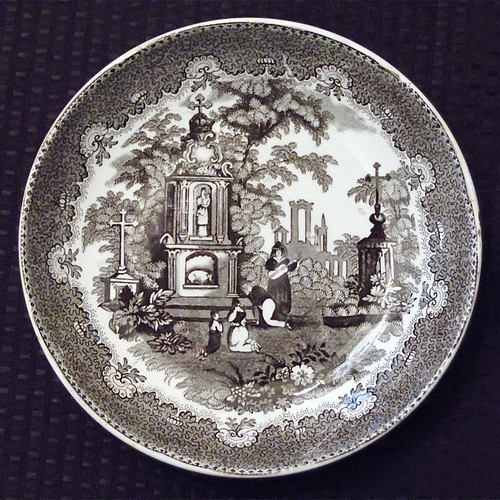
Plate depicting a cemetery visit.
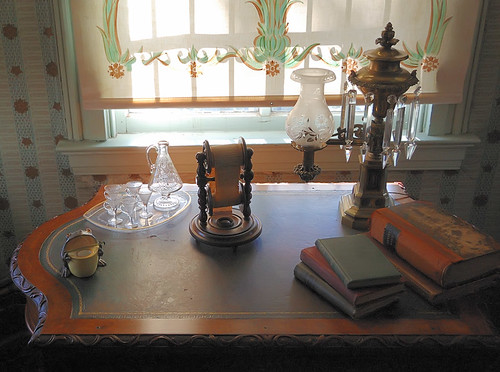
From a history of the house:
The Mansion was built in two sections by families with very different lifestyles. Henri Chatillon built the first section, a four-room brick farmhouse, in 1848. He was a guide and hunter for the American Fur Company of St. Louis in the 1840's before settling permanently in the area with his second wife, Odile Delor Lux. Chatillon served as a guide for Francis Parkman, Jr. in 1846. Parkman wrote about their trip in his book "The Oregon Trail."
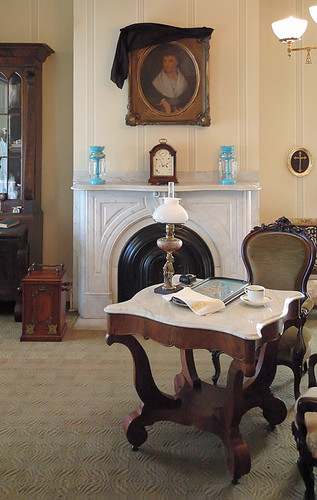
Continuing the history:
Chatillon sold the "farmhouse" in 1856 to Dr. Nicolas N. DeMenil, a well known physician and part owner of the first chain of drug stores in St. Louis. DeMenil was a wealthy Frenchman. He came to St. Louis in 1834 and married Emilie Sophie Chouteau, who was a descendant of St. Louis' founding family. The DeMenils originally used the home as a summer retreat. In 1861, the DeMenils hired English architect Henry Pitcher to add on the extra rooms and turn the farmhouse into a Greek Revival Mansion. At that time they moved into the home permanently. The addition was completed in 1863.This was at the time a wealthy German neighborhood. This class generally believed in industrialization and a strong central government, and their influence greatly shaped the Republic after the War Between the States.
Although the maps call this locale the Marine Villa district, most people refer to it as the Lemp neighborhood. The house sits between the Anheuser-Busch brewery and the former Lemp brewery. In the days before artificial refrigeration, this area was good for brewing because of the cool caves that are found in this area. The style of beer brewed here is called Lager, after the German word for ‘storehouse’, which requires a chilly environment for fermentation and aging.
The historic Lemp Mansion is next door, and it is also open for dining and tours. However, many of the Lemp family unfortunately had unhappy lives and deaths compared to their neighbors.
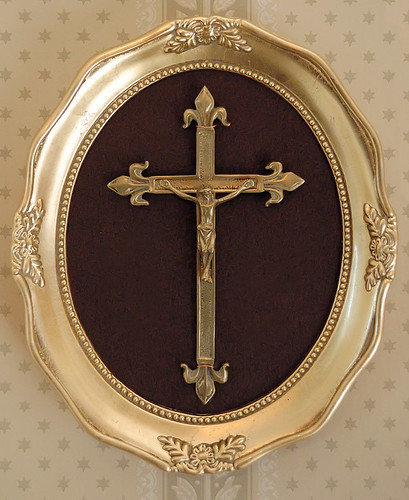
More history:
Three generations of the DeMenil family occupied the home until 1929. From that year until 1945 the Mansion was maintained by caretakers. Lee Hess bought the property in 1945 to develop a tourist attraction based upon the natural system of caves that lie beneath the area. The "Cherokee Caves" were quite popular but the house itself suffered. When Interstate 55 was being planned in the early 1960's the house was going to be torn down. The Landmarks Association decided to buy the land and home from the State of Missouri Highway Commission. They wanted to save the Mansion, because it is one of the only remaining examples of Greek Revival architecture in St. Louis. With a $40,000 gift from Union Electric they bought the house and land. Restoration of the Mansion began in the summer of 1964. Formal dedication of the restored Mansion took place in May 1965. Then the Chatillon-DeMenil Foundation took control of the Mansion.
Structurally, the Mansion today is as the DeMenil family left it in 1929. All the ceiling medallions, marble mantelpieces, front hall parquet foor, and front hall chandelier are original to the house. Most of the furniture is dated between 1830 and 1880, with some original DeMenil pieces. Wallpapers, curtains, and carpets throughout the house are reproductions of original designs.
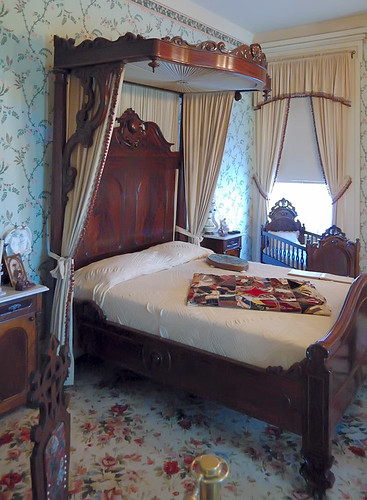
The bedroom of the lady of the house.
Although the owners of the house were wealthy, they did not own slaves. The sharply divided public opinion in the run-up to the American Civil War was reflected within this household. Mrs. DeMenil, descended from the founders of Saint Louis, was in favor of the Southern cause like many of the local French. Her husband, Dr. DeMenil, like many of the newly-immigrated Germans here, had Northern sympathies.
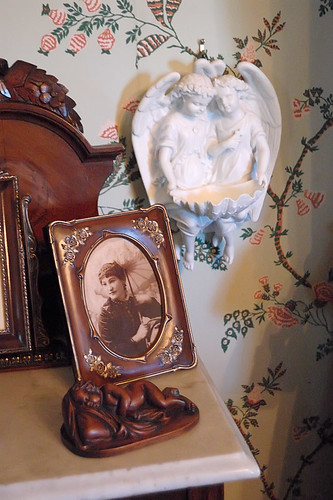
Holy water font next to the bed.
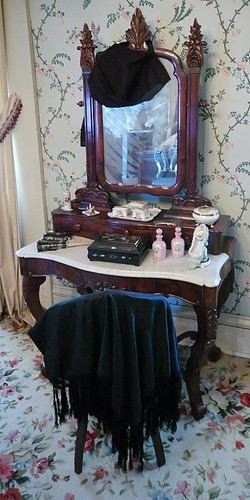
A vanity table.
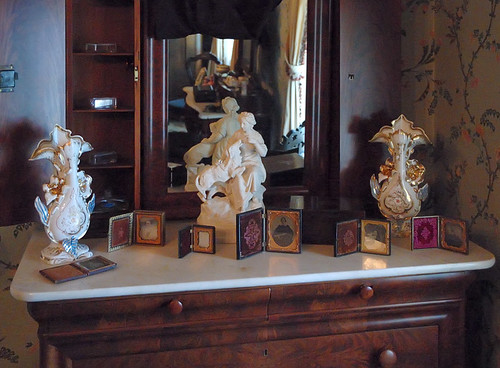
This building is called a mansion, but it is not a particularly large home; it does have a higher level of architectural detail compared to the spacious working-class structures built in the nearby Soulard neighborhood. All these buildings share a feature that once was nearly universal in construction: high ceilings, which are quite helpful in the summer heat. The rooms here are numerous but fairly small.

The bedroom of the gentleman of the house. Separate bedrooms for married couples were desirable if they could be afforded. Privacy was always valued. Most particularly, there were no bathrooms, but rather chamber pots were in each bedroom.
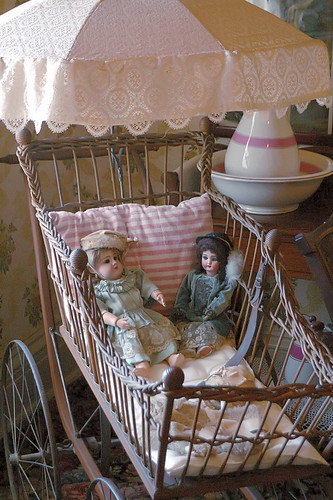
Antique dolls.
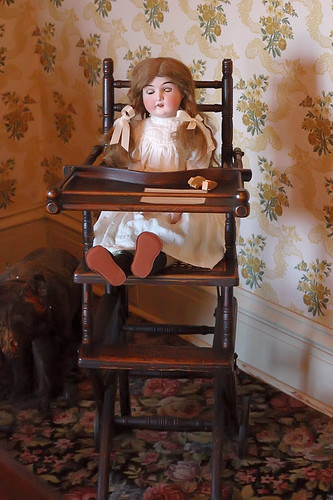
This doll had hair taken from the little girl who owned it.
The ancient custom of keeping relics of loved ones was still quite strong in that period: soldiers who went off to war would leave behind a lock of hair.
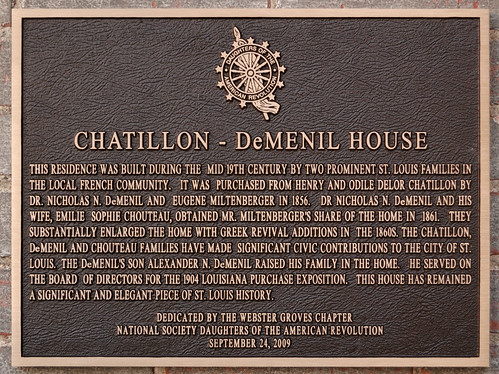
I visited the house on the occasion of the formal dedication of this historical marker by the Daughters of the American Revolution, which featured a Marine honor guard, Pledge of Allegiance, a prayer, and singing of the National Anthem.
Address:
3352 DeMenil Place
St. Louis, MO 63118


No comments:
Post a Comment